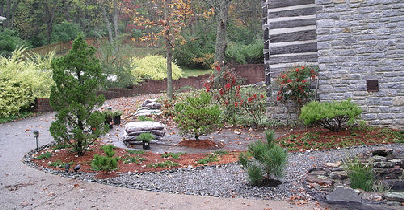Plan wisely for the permanent planting of shrubs
The most common mistake made by both novice and experienced gardeners, is planting a shrub too close to a foundation, fence, or other structure. You see it all the time, bushes that have become full grown crowded up to the base of a home, a too large shrub covering a window, or the back half sheared off because it has grown into or through a fence.
Unlike annuals and perennials, shrubs are not easily moved once established. If you have not chosen carefully and allowed enough space for the shrub when full grown, you will find yourself doing some lopsided over pruning to make it fit, and eventually removing it before it has completed a healthy life. If you realize your mistake early enough, moving the shrub may be successful. Or you may be able to maintain an appropriate size by consistent pruning.
When planning a large area for planting, it really is best to lay out a map on graph paper. Start with your property plat map if you have it, to make the initial boundary and structure measurement and layouts easier. If you can’t find your plat map, you need to do some measuring. Start with all the permanent structures, including house and garage, and driveway. Measure from those to the street, to property lines and fences, light poles, established trees, and any other permanent items in your property. It’s a bit time consuming, but after a couple of “drafts” to get everything laid out properly, you now have a “master” layout of your property. Make some copies for planning and editing in pencil, but only alter your original master when you have added permanent or “semi-permanent” items to the property. The semi-permanent should be done in pencil so that if a shrub or tree fails to thrive and you need to attempt to move it or it dies, it’s place on the master plan can easily be changed.
When you are ready to start experimenting with a plan, you can either pencil things in on your working copy, or use cut out pieces that you can move around and eventually either paste down or trace onto the plan Make sure you plan for the full grown size of a plant you are considering, as well as a little buffer space between plants, unless you are planning a dense screen or hedge. A little overlap would be appropriate, but not enough to inhibit good growth. Allow enough space between a shrub and a permanent structure to be able to walk between to accommodate pruning to the plant, and maintenance to the structure. Note overhead limitations such as decks, awnings, even power lines, as well as windows, so that the ultimate height of your shrub does not become a problem. The first year or two will be spent establishing a strong root system and adapting to the soil. Then it will begin to grow quite quickly. Some trimming may be appropriate to maintain a uniform shape and encourage fullness. Most shrubs reach their full size in 5-10 years, and you will be amazed at how quickly that time passes. The photo at left shows just 3 years growth of a mixed bed (shrubs and perennials) that has already taken over the front of the house. Very fast growing shrubs and trees generally have a shorter life, and limbs are not as strong as the slow growers.
Don’t forget about future plans for a patio, pool, or other structural addition to your property. Will your current selections be too large? cast shade where you want sun? or have to be removed altogether?

